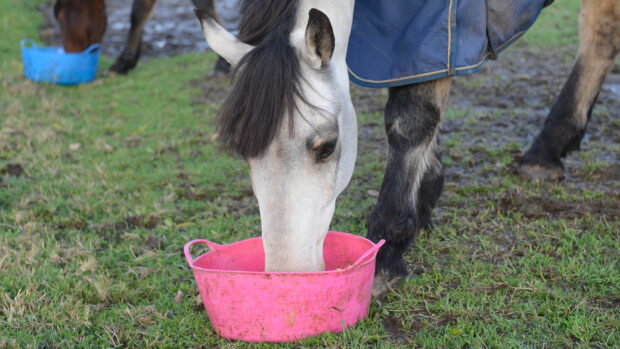The biomechanics of jumping leave showjumpers at particular risk from concussion-related degenerative joint disease (DJD) in the forelimbs. DJD is the progressive inflammation of a joint due to trauma or wear and tear, which leads to erosion of articular joint cartilage, causing pain and loss of function.
This cartilage covers the ends of the bones and absorbs most of compression and stress placed on the joint. It is made of a slippery material, which allows the joints to move easily. It has no nerve or blood supply and receives all its nutrition from the synovial fluid, which surrounds it within the joint capsule.
The majority of this damage occurs on landing when the vertical movement is transferred into forward, horizontal movement. The non-lead foreleg hits the ground first, at an angle of approximately 90o to the ground, bearing the brunt of the landing force. The leading foreleg lands a fraction of a second later at an angle of 68o, causing the horse to slow down.
Factors that influence the levels of concussive forces placed on the limbs include:
- The height of fence
- The speed of approach
- The rider’s ability
- The horse’s ability
Drug-free solutions
In the past, horses with joint problems were commonly prescribed phenylbutazone (bute) to reduce the inflammation and pain associated with DJD. However, new research suggests that the ongoing use of bute in horses with joint problems could be causing more problems than it is preventing.
A recent study has shown that bute and other non-steroidal anti-inflammatory medications (NSAID’s) might be detrimental to joint cartilage regeneration in horses, leading to increased interest in alterative treatments.
There are substances available, such as MSM and glucosamine hydrochloride, which can be added to the diet to help prevent and treat DJD. Antioxidants are also essential as these help prevent cartilage damage caused by free radicals. Furthermore, several herbs are renowned for their anti-inflammatory properties, which help to decrease any pain associated with DJD.
Methyl Sulphonyl Methane (MSM)
A source of bio-available sulphur necessary for the synthesis of cartilage, which may help reduce cartilage degeneration. MSM can inhibit pain, promote blood flow and reduce inflammation of tissues making it useful in the treatment of DJD.
Glucosamine Hydrochloride
Glucosamine is a combination of sugar and a part of an amino acid (amine) which occurs naturally in the cartilage and joint fluid and is essential for the maintenance of joint integrity. The body’s natural glucosamine can be lost as a result of ageing and mechanical damage, so supplementation may be required. The hydrochloride is a salt which carries the glucosamine to the horse’s stomach where it is ingested and absorbed rapidly into the blood steam. Almost 90% of glucosamine administered orally is absorbed from the stomach.
Glucosamine works by stimulating the production of proteoglycans that work alongside collagen to support connective tissue. They help restoring damaged chondrocytes, which form cartilage tissue and help to increase the levels of hyaluronate, a component of synovial fluid.
Antioxidants
Several antioxidants including Vitamin C are essential to help reduce joint damage caused by free radicals. Free radical production will be increased with regular exercise and competitions and therefore dietary antioxidant supplementation will be of benefit.
Herbs
Uncaria tomensata is a Peruvian herb known as “cat’s claw” in the UK. It is reputed to have potent anti-inflammatory effects, which are useful in the treatment of arthritis and rheumatism. It also has antioxidant properties and helps protect cells from damage caused by free radicals.
Research has indicated that boswellic acids, as found in Boswellia serrata, have an anti-inflammatory action similar to NSAID’s without causing any of the adverse side-effects associated with long term NSAID use.
Tests have shown that Devil’s claw (Harpogophytum procumbens) may help reduce pain associated with DJD’s and has beneficial effects comparable with cortisone and Bute without the attended side-effects.
Preventing problems
Competition horses, including show jumpers, can develop lameness and joint problems for a number of reasons, but simply steps to help prevent these problems include:
- Providing routine hoof care every 6-8 weeks
- Avoiding obesity and heavy loads
- Avoiding quick changes in duration or intensity of exercise
- Avoiding hard and unstable ground surfaces
- Feeding a balanced diet
- Feeding a good quality joint supplement
While showjumpers may be more susceptible to DJD due to the nature of the sport, a balanced diet is essential to maintain healthy joints in all horses and should be considered by all owners, whether their horses jump 1ft or 6ft fences.
|
Feeding antioxidants
Dodson & Horrell’s extensive range of feeds and supplements suitable for horses which may be susceptible to DJD includes Ultimate Balancer, Mobility Herbal Blend, Devil’s Claw. For expert advice on formulating a balanced diet for your horse, contact Dodson & Horrell’s feed helpline (tel: 0870 442 3322) or visit: www.dodsonandhorrell.com |


